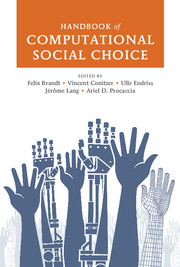Book contents
- Frontmatter
- Contents
- Foreword
- Contributors
- 1 Introduction to Computational Social Choice
- Part I Voting
- 2 Introduction to the Theory of Voting
- 3 Tournament Solutions
- 4 Weighted Tournament Solutions
- 5 Dodgson's Rule and Young's Rule
- 6 Barriers to Manipulation in Voting
- 7 Control and Bribery in Voting
- 8 Rationalizations of Voting Rules
- 9 Voting in Combinatorial Domains
- 10 Incomplete Information and Communication in Voting
- Part II Fair Allocation
- Part III Coalition Formation
- Part IV Additional Topics
- References
- Index
2 - Introduction to the Theory of Voting
from Part I - Voting
Published online by Cambridge University Press: 05 May 2016
- Frontmatter
- Contents
- Foreword
- Contributors
- 1 Introduction to Computational Social Choice
- Part I Voting
- 2 Introduction to the Theory of Voting
- 3 Tournament Solutions
- 4 Weighted Tournament Solutions
- 5 Dodgson's Rule and Young's Rule
- 6 Barriers to Manipulation in Voting
- 7 Control and Bribery in Voting
- 8 Rationalizations of Voting Rules
- 9 Voting in Combinatorial Domains
- 10 Incomplete Information and Communication in Voting
- Part II Fair Allocation
- Part III Coalition Formation
- Part IV Additional Topics
- References
- Index
Summary
Introduction to an Introduction
Suppose a finite society is about to vote on a choice of one option from among finitely many. The options, called alternatives in voting theory, might be candidates for mayor of a town, or different amounts to spend on building a new firehouse, or several versions of an immigration reform bill. If we assume that
every two voters play equivalent roles in our voting rule
every two alternatives are treated equivalently by the rule
there are only two alternatives to choose from
then the situation is simple: May's Theorem, discussed in Section 2.4, tells us that the only reasonable voting method is majority rule.
Many voting contexts, however, require us to relax some of these assumptions. In these settings, the matter of choosing a voting rule can become much less straightforward. What are the principal issues that complicate matters? Contexts for voting vary too greatly to admit any unified answer, so we will have to narrow the question.
Our focus here is on the context of multicandidate voting, for which an appropriate metaphor is that of electing a mayor when there are three or more candidates—so we will relax the third condition, while holding out for the first two. Even within this framework, “voting” can mean different things, depending on the specified form of a ballot and of a collective decision. Our primary concern will be with ranked ballots— each voter submits a linear ordering of the alternatives, specifying their most favored candidate, their second choice, and so on—and with single winners (or several winners, in the event of a tie) as outcomes. A voting rule in this setting is called a social choicefunction or SCF (see examples in Section 2.2).
Within multicandidate voting, three results are most prominent. The first, observed by Marie Jean Antoine Nicolas de Caritat, Marquis de Condorcet (1785) and arguably most fundamental, is the existence of majority cycles, in which collective preference violates what we might expect from any “rational” individual: a majority of voters prefer some alternative a to b, a (different) majority prefers b to c, and a third majority prefers c to a.
Kenneth Arrow's Independence of Irrelevant Alternatives principle (aka IIA) asserts that collective voter opinion as to the relative merits of two alternatives should not be influenced by individual voter opinions about an “irrelevant” third.
- Type
- Chapter
- Information
- Handbook of Computational Social Choice , pp. 23 - 56Publisher: Cambridge University PressPrint publication year: 2016
- 28
- Cited by



